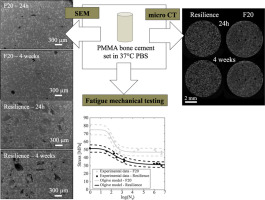Journal of the Mechanical Behavior of Biomedical Materials ( IF 3.3 ) Pub Date : 2018-03-08 , DOI: 10.1016/j.jmbbm.2018.03.001 Céline Robo , Caroline Öhman-Mägi , Cecilia Persson

|
Vertebroplasty (VP) is a minimally invasive surgical procedure commonly used to relieve severe back pain associated with vertebral compression fractures. The poly(methyl methacrylate) bone cement used during this procedure is however presumed to facilitate the occurrence of additional fractures next to the treated vertebrae. A reason for this is believed to be the difference in stiffness between the bone cement and the surrounding trabecular bone. The use of bone cements with lower mechanical properties could therefore reduce the risk of complications post-surgery. While intensive research has been performed on the quasi-static mechanical properties of these cements, there is no data on their long-term mechanical properties. In the present study, the in vitro compressive fatigue performance as well as quasi-static mechanical properties of two commercially available acrylic bone cements – a low-modulus cement (Resilience®) and a standard cement (F20) from the same manufacturer – were determined. The quasi-static mechanical properties of the low-modulus and standard cements after 24 h of setting were in the range of other vertebroplastic cements (σ = 70–75 MPa; E= 1600–1900 MPa). F20 displayed similar mechanical properties over time in 37 °C phosphate buffered saline solution, while the mechanical properties of the Resilience® cement decreased gradually due to an increased porosity in the polymeric matrix. The standard cement exhibited a fatigue limit of approx. 47 MPa, whereas the low-modulus cement showed a fatigue limit of approx. 31 MPa.
In summary, the low-modulus bone cement had a lower fatigue limit than the standard cement, as expected. However, this fatigue limit is still substantially higher than the stresses experienced by vertebral trabecular bone.
中文翻译:

用于椎体成形术的市售标准和低模量丙烯酸骨水泥的压缩疲劳特性
椎体成形术(VP)是一种微创手术程序,通常用于缓解与椎骨压缩性骨折相关的严重背痛。但是,假定在此过程中使用的聚(甲基丙烯酸甲酯)骨水泥可促进在治疗椎骨旁出现其他骨折。认为其原因是骨水泥与周围的小梁骨之间的刚度不同。因此,使用具有较低机械性能的骨水泥可以降低手术后出现并发症的风险。尽管已对这些水泥的准静态力学性能进行了深入研究,但尚无有关其长期力学性能的数据。在目前的研究中,确定了®)和同一制造商的标准水泥(F20)。凝固24小时后,低模量水泥和标准水泥的准静态力学性能在其他椎骨水泥的范围内(σ= 70-75 MPa; E = 1600-1900 MPa)。F20显示类似的机械性能在超过37℃的磷酸盐缓冲盐水溶液的时间,而韧性的机械性能®水泥由于在聚合物基质中的增加的孔隙率逐渐降低。标准水泥的疲劳极限约为。47 MPa,而低模量水泥的疲劳极限约为。31兆帕。
综上所述,低模量骨水泥的疲劳极限比标准水泥低,正如预期的那样。但是,该疲劳极限仍然大大高于椎骨小梁骨所承受的应力。










































 京公网安备 11010802027423号
京公网安备 11010802027423号